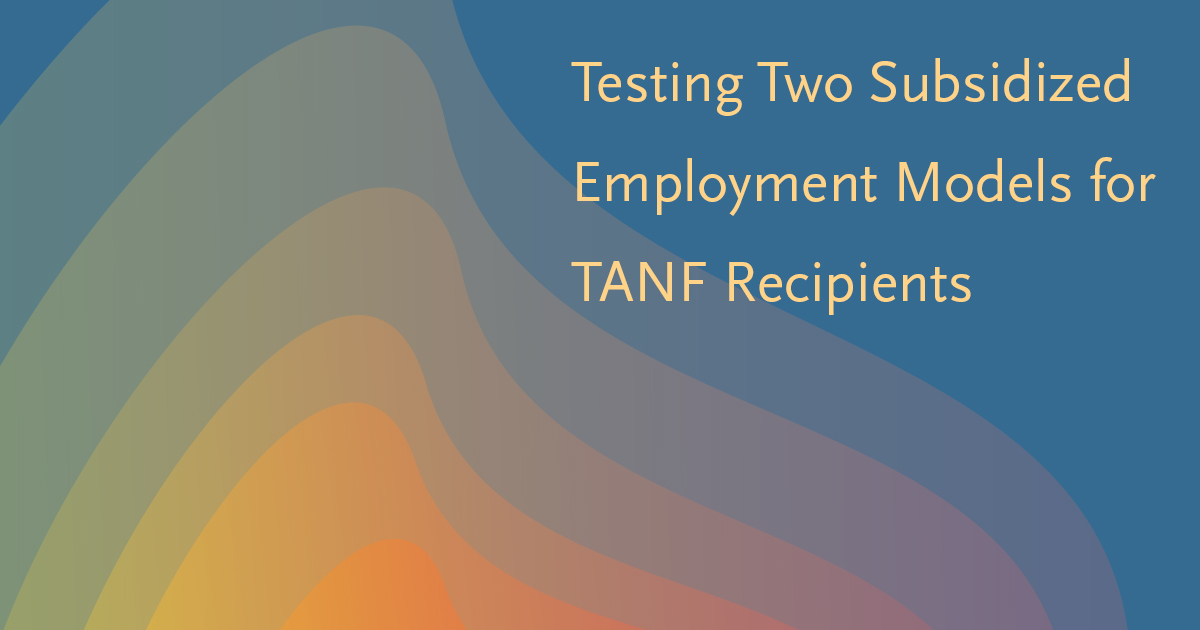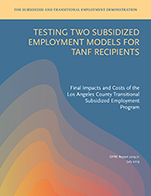Testing Two Subsidized Employment Models for TANF Recipients
Final Impacts and Costs of the Los Angeles County Transitional Subsidized Employment Program

 Introduction
Introduction
Securing employment in a competitive labor market can be difficult for job seekers with limited education or work experience, especially if they are single parents or caring for young children. Some public assistance programs — Temporary Assistance for Needy Families (TANF) programs, for example — attempt to make participants who cannot find employment in the regular labor market more employable by offering them “subsidized employment,” or temporary jobs subsidized with public funds. Subsidized employment can be designed to teach participants basic work skills, provide them with work experience that can be used on future résumés, and help them get a foot in the door with employers. Past research has found mixed results regarding these programs’ ability to affect participants’ employment rates or earnings in the long term. This varied track record has pushed the field to identify new models for subsidized employment. This study uses a random assignment design to evaluate two approaches to subsidized employment for TANF recipients in Los Angeles County.
Primary Research Questions
The evaluation aims to answer the following research questions:
-
How were these two approaches to subsidized employment designed and operated?
- What are the effects of the two models on employment and earnings, TANF receipt, combined income, and overall well-being, relative to what would have happened in the absence of the subsidized employment program?
- Which of the two models appears to be more effective, and for which population subgroups?
- To what extent do the costs of the two models differ from the amounts spent on those who were not offered the program services? How does this cost differential relate to the benefits associated with any program effects?
Purpose
MDRC evaluated two distinct approaches to subsidized employment for TANF recipients in Los Angeles County. The study is part of the Subsidized and Transitional Employment Demonstration, sponsored by the Administration for Children and Families in the U.S. Department of Health and Human Services. The first model studied, Paid Work Experience (PWE), subsidizes the wages of individuals placed at employers in the nonprofit or public sector for up to six months. The second, On-the-Job Training (OJT), offers wage subsidies to for-profit employers who agree to place employees onto their payrolls after an initial two-month tryout period; if they do, the wage subsidies can continue for up to an additional four months.
Key Findings
Findings from the evaluation include the following:
-
The two models differed substantially in terms of their subsidized employment placement rates and the duration of those placements, and there was considerable variation in the quality of implementation across service providers. Forty-two percent of OJT group members were placed in subsidized employment, compared with 79 percent of PWE group members. Compared with OJT placements, PWE placements were far more likely to continue for more than two months. Placement rates and durations varied across the 21 organizations that were contracted to run the program models; variation was particularly substantial for OJT.
-
As expected, both models led to large increases in employment and earnings during the first year of follow-up. In the first year after random assignment, both PWE and OJT group members were more likely to work, worked more quarters on average, and had higher average earnings than control group members. These differences were largest among sample members who had not been employed in the year before random assignment, and they declined as participants left subsidized jobs.
-
There is some evidence that PWE led to a small positive impact on employment in the last year of follow-up and that this effect was concentrated among those with little recent work experience. Employment in the last year of follow-up was 4 percentage points higher for PWE group members compared with control group members, and this effect appeared to be concentrated among those who had not been employed in the year before random assignment. Additionally, there is some evidence that PWE may have led to group members obtaining better-quality jobs, in terms of weekly hours worked, hourly wages, and employer-provided health insurance, at the end of the follow-up period. The OJT model did not have noteworthy long-term impacts on any of the outcome domains.
-
PWE’s small impact on employment in the last year of follow-up was not large enough to significantly reduce TANF receipt rates or increase income in the long term.
-
The government spent more on the PWE and OJT groups than it spent on the control group, and more on the PWE group than on the OJT group. The net cost was $4,701 per PWE group member and $2,046 per OJT group member.
Methods
This evaluation includes an implementation study, an impact study, and a cost analysis. This report presents final impact results (after 30 months) and cost analysis findings. Findings from the implementation study and one-year impact results are summarized in this report and presented in full in a 2016 report.
The implementation study described the design of the PWE and OJT models and assessed how they operated. Data sources for the implementation study include staff interviews, observations, and participation data. The impact study used a random assignment design in which individuals eligible for and interested in the subsidized jobs program were randomly assigned to a PWE program group, an OJT program group, or a control group that did not have access to either of these subsidized employment models but was required to participate in other welfare-to-work activities. The study evaluated impacts on education and training, employment and earnings, TANF receipt, combined income, and well-being. Data sources for the impact study included administrative records on earnings, TANF receipt, and food stamp receipt; subsidized employment payroll records; and surveys conducted approximately 4, 12, and 30 months after sample members entered the study. The cost study assessed the one-year costs of the two models and the difference in the cost of services provided to the program groups relative to the control group. Data sources for the cost study included operating costs, costs of supportive services, and wages and payroll costs supplied by program providers and oversight organizations.







